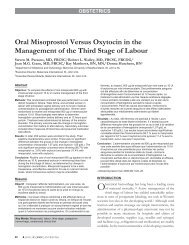Lily Eghdami - UBC Department of Obstetrics & Gynaecology
Lily Eghdami - UBC Department of Obstetrics & Gynaecology
Lily Eghdami - UBC Department of Obstetrics & Gynaecology
You also want an ePaper? Increase the reach of your titles
YUMPU automatically turns print PDFs into web optimized ePapers that Google loves.
Fertility and Sterility®International Statistical Classification <strong>of</strong> Diseases and RelatedHealth Problems (ICD)-9 codes 390–459 (diseases <strong>of</strong> the circulatorysystem) or 745–747 (anomalies <strong>of</strong> the cardiovascularsystem), or ICD-10 codes I (diseases <strong>of</strong> the circulatory system)and Q20–28 (anomalies <strong>of</strong> the cardiovascular system). Mortalitydue to cancer was based on cause <strong>of</strong> death attributedto ICD-9 codes 140–208 (neoplasms) and ICD-10 code C (neoplasms).Analyses <strong>of</strong> cause-specific mortality excluded 419participants with unknown cause <strong>of</strong> death.Statistical AnalysisBaseline characteristics by type <strong>of</strong> menopause (surgical due tobilateral oophorectomy vs. natural) were compared using thec 2 test. Multivariable Cox proportional hazards regressionmodels, with age (in days) as the time scale, provided estimates<strong>of</strong> the relative risks (RR) and the 95% confidence intervals(CI) for all-cause mortality, cardiovascular mortality, andcancer mortality. Participants were followed from cohort entryuntil the first <strong>of</strong> the following events: death, move out <strong>of</strong>the United States, or end <strong>of</strong> follow-up period, which was December31, 2007. The models for all-cause mortality were adjustedfor baseline, self-reported measures <strong>of</strong> BMI (16–24.9kg/m 2 ,25–29.9 kg/m 2 ,30–54.9 kg/m 2 , or unknown), race(white, African American, or other), smoking history (neversmoker, former smoker, or current smoker), prior history <strong>of</strong>diabetes (yes or no), prior history <strong>of</strong> high blood pressure(yes or no), prior history <strong>of</strong> heart attack/myocardial infarction(yes or no), and prior history <strong>of</strong> at least one <strong>of</strong> the followingcancers: lung, leukemia, Hodgkin’s lymphoma, other lymphoma,colorectal, thyroid, and melanoma (yes or no). Themodel with all participants was additionally adjusted forage at exposure (natural menopause or bilateral oophorectomy).The models for cardiovascular mortality were configuredin the same manner as described above for all-causemortality, except they were not adjusted for prior history <strong>of</strong>heart attack/myocardial infarction. The models for cancermortality were configured in the same manner as describedabove for all-cause mortality, except that they were not adjustedfor prior personal history <strong>of</strong> at least one <strong>of</strong> the followingcancers: lung, leukemia, Hodgkin’s lymphoma, otherlymphoma, colorectal, thyroid, and melanoma (yes or no);and they were additionally adjusted for family history <strong>of</strong> atleast one <strong>of</strong> the following cancers: breast, endometrium,ovary, cervix, lung, leukemia, Hodgkin’s lymphoma, otherlymphoma, colorectal, prostate, thyroid, or melanoma (yesor no). All Cox models were fit using the PHREG procedurein SAS version 9.2 (SAS Institute). In light <strong>of</strong> the longfollow-up period under consideration the STRATA¼VARI-ABLE statement in the PHREG procedure was used to adjustfor any cohort effect; the strata variable was set to age (inyears) at cohort entry, a proxy for birth year. The use <strong>of</strong> ageat cohort entry in years vs. use <strong>of</strong> a categoric variable forage at cohort entry (i.e., 5-year intervals) in the STRATAstatement ensures that any effect <strong>of</strong> a single important publicationor event would be adjusted for and is made possible bythe large sample size <strong>of</strong> the CTS.Because many women who undergo surgical menopausedue to bilateral oophorectomy begin HT use shortly thereafter,we also performed stratified analyses based on HT use (evervs. never) at baseline. Ever-users were further stratified byformulation (ET only vs. estrogen plus progestin therapy[EPT] only) in an analysis that excluded participants whoused more than one formulation. Models were also stratifiedby age at natural/surgical menopause (
116 VOL. 97 NO. 1 / JANUARY 2012TABLE 3Relative risk (95% CI) <strong>of</strong> all-cause and cause-specific mortality by ever use <strong>of</strong> menopausal HT in the form <strong>of</strong> ET or EPT, overall and by age at natural menopause or age at bilateral oophorectomy in42,004 CTS participants, 1995–2007.VariableAllAge at natural menopause or age at bilateral oophorectomy
















